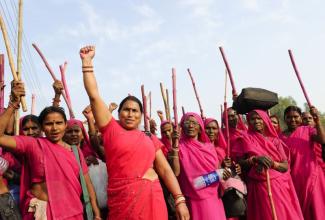Repression of NGOs
New Indian authoritarianism

In the blistering heat of an Andhra Pradesh summer, a curious campaign popped up in the villages: “Adopt a granny”. Posters were hung up in every conceivable place by a well-meaning and well-funded international NGO (INGO). It apparently had no clue that, in the joint family system in Indian villages, grannies live with their grandchildren. The children needed schools, medicines and playgrounds. Grannies they had.
In spite of occasional cases of INGO ignorance and considerable domestic development efforts, India needs global NGO presence for meaningful intervention. Kailash Satyarthi, the Indian children’s-rights activist, won the Nobel peace price despite there being no support from India. Support came from abroad. Elsewhere national activists are making a difference across the socio-ecological landscape. There is funding too with Indian companies required to spend a mandatory two percent of profits on Corporate Social Responsibility, thus channelling some 20 billion rupees ($ 300 million) every year into development aid.
INGO support often strengthens Indian civil-society organisations, empowering them to stand up to the Indian state agencies, not least because international attention provides some protection against repression. That was evident, for instance, in the Ford Foundation’s support for Teesta Setalvad’s activism in defence of victimised minorities in the western Indian state of Gujarat or Anna Hazare’s anti-corruption campaign in 2011. Greenpeace India provides another example of standing up for the rights of indigenous Indian communities that are being trampled upon by the mining mafia. Such activism bothered the current national government so much that it has begun to crack down on foreign funding for NGOs in general (see Dinesh Sharma in D+C/E+Z 2015/03, p. 43), cutting Greenpeace India’s access to funds from abroad in September.
The state government of Gujarat has similarly accused the Ford Foundation of “interfering in the internal affairs” of India and “abetting communal disharmony”. The national government has limited the access of Setalvad’s NGO to foreign funding.
This is a troublesome development. The Ford Foundation has been active in India since 1953. So far, its total donations amount to half a billion dollars. Amongst other things, it has supported campaigns for civil liberties and environmental protection, two crucially important matters in India. Human-rights and environmental activists have benefited considerably from INGO support.
INGOs are often better in touch with grassroots-level needs than the aid agencies of donor governments. The development activist and scholar David C. Korten said: “Disillusioned by the evident inability of USAID and other large official aid donors to apply the approaches that had been proven effective by the non-governmental Ford Foundation, I eventually made my break with the official aid system.”
It is worth bearing in mind, of course, that corporate interests do not only have a major impact on governments in rich nations, they also have an impact on civil society. Consider the World Social Forum (WSF), for example, which is arguably the most potent forum for non-government organisations, advocacy groups and other formal and informal social movements. It has been funded by a consortium of corporate foundations under the advisory umbrella of Engaged Donors for Global Equity (EDGE), earlier called the Funders Network on Trade and Globalisation.
To Indian activists, the dominance of experts from northern countries in international civil society is sometimes irritating. There is no doubt, however, that the overall impact of INGOs is helpful, not destructive.
Three million NGOs in India
Reportedly, there are more than 3 million minuscule to large NGOs in India. Around 40,000 are registered under laws regulating federal funding. From 2002 to 2012, they received funds worth about $ 7 billion under the Foreign Contribution Regulation Act (FCRA), according to private sources. The government places the figure at $ 14 billion. US-based organisations topped the donor list, followed by organisations from the UK and Germany.
In 2010, the previous Congress-led government amended the FCRA, specifically seeking to regulate foreign-funded NGOs. Since then, 13,500 foreign-funded NGOs saw their registrations cancelled because of failure to file returns as mandated. The current BJP-led government has even made sure that the Supreme Court Bar Association which organises lawyers and the All India Lawn Tennis Association no longer get foreign money. The same is true of many premier educational institutions like the Jawaharlal Nehru University, the Indian Council of Agricultural Research, the Sardar Patel University and the National Institute of Fashion Technology.
There is little doubt, however, that the NGO community, warts-and-all, is a bulwark of a democratic way of life. It is currently under attack in India. Ironically, the government is sending out the message that foreign direct investment is fine but international engagement in domestic human-rights and justice battles is not. This trend of authoritarianism, unfortunately, is also evident in other countries, from Russia to Uganda and from Cambodia to Kenya.
As the Indian government wants to move ahead with industrialisation, it is neglecting and repealing environment laws, promoting deforestation and trampling on tribal rights. It sees international support for civic opposition in India as contributing to slowing down and even stalling development projects such as nuclear power plants, uranium mines, coal-fired power plants, farm biotechnology, mega industrial projects, hydroelectric plants and extractive industries.
Global watchdog presence has proven very useful in cases of campaigns against nuclear power plants being built without people’s consent and other socially relevant projects. In 2014, for example, researchers from top US universities exhibited prototypes of the next-generation toilet at the Bill and Melinda Gates Foundation’s “Reinvent the Toilet Fair” in India. The current anti-NGO position may affect such close collaboration to address India’s critical needs and cut the country off “from a lot of potential benefits in the world, not just money but also real inventions and innovations”, warns Thomas Blom Hansen, a professor of South Asian studies at Stanford University in the USA. His chair, by the way, is named after Dhirubhai Ambani, the founder of Reliance industries, India’s leading corporate giant and sponsor of Stanford University. Corporate influence goes both ways in today’s globalised world, and so should civic activism.
Aditi Roy Ghatak is an Indian journalist.
aroyghatak1956@gmail.com










